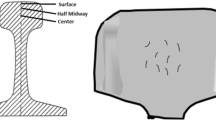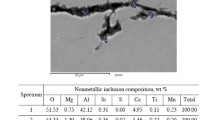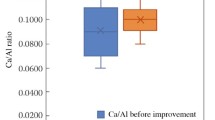Abstract
Current trends in the production of railroad wheels show the use of some promising techniques: a reduction in the carbon content of the finished steel; degassing the steel in a vacuum to decrease its hydrogen content; more efficient deoxidation and alloying of the steel. When used together, these measures are ensuring that the finished steel has the mechanical and service properties prescribed for wheel steel. Studies and factory testing of a new technology for making wheel steel have shown that the oxygen content of the steel can be reduced by its self-deoxidation during vacuum degassing. This approach also helps lower the steel’s hydrogen content while saving deoxidizers. Researchers have discovered certain laws that govern the relationship between the characteristics of wheel steel and its contents of sulfur and gases. The amount of sulfur and gases in this type of steel can be reduced by using efficient parameters for the treatment that is administered outside the steelmaking furnace.
Similar content being viewed by others
References
Ph. Cassidy, “Promising materials for making wheels,” Int. Railway J., No. 12, 40–41 (2001).
W. Harris, S. Zakharov, D. Landgren, H. Turne, and W. Eberson, Survey of Progress in Heavy Transport: Aspects of the Interaction of Railroad Wheels and Rails [in Russian], Intext, Moscow (2002).
G. Stevenot and F. Demilly, Revue Generale des Chemins de Fer, No. 5, 33–39 (2002).
I. Poschmann and C. Heermant, Eisenbahningenieur, No. 8, 47–51 (2002).
I. G. Uzlov, M. I. Gasik, A. T. Esaulov, et al., Wheel Steel [in Russian], Tekhnika, Kiev (1985).
Yu. S. Proidak, “Improving the quality of rail steel through different treatments outside the steelmaking furnace,” Metallurg. Gornorud. Promst., No. 2, 32–35 (1998).
B. I. Medovar, M. I. Gasik, Yu. S. Proidak, et al., “Effect of the composition and morphology of nonmetallic inclusions on the mechanical properties of wheel steel,” Probl. Spetselektromet., No. 3, 7–12 (1993).
W. Vantuono, Railway Age, No. 4, 61–65 (2000).
G. Knuppel, Deoxidation and Vacuum Degassing of Steel [Russian translation], Metallurgiya, Moscow (1973).
V. P. Luzgin, A. V. Kachevan, and A. S. Bliznyukov, “Change in oxygen content during the out-of-furnace treatment of steel,” Izv. Vyssh. Uchebn. Zaved. Chern. Metall., No. 1, 10–13 (2001).
V. V. Tyagnii, V. A. Kravchenko, A. A. Deryugin, et al, “Gas saturation of wheel steel and its effect on the reliability and durability characteristics of railroad wheels and tires,” Metallurg. Gornorud. Promst., No. 7, 158–163 (2002).
V. V. Tyagnyy, A. A. Deryugin, V. A. Kravchenko, et al., “Gas saturation of wheel steel and its influence over the reliability characteristics and useful life of railway wheels and tires,” in: Railway Wheel Sets (Projecting, Producing, Operating, Repairing), CD-ROM of Proc. of 5th Int. Scientific Conference for Middle and Eastern European Countries, Katowice, July 3–5, 2002.
Author information
Authors and Affiliations
Additional information
__________
Translated from Metallurg, No. 8, pp. 56–60, August, 2006.
Rights and permissions
About this article
Cite this article
Tyagnii, V.V., Stovpchenko, A.P., Chuprina, L.V. et al. Current trends in the production of railroad wheels and the effect of out-of-furnace treatment of the steel on their properties. Metallurgist 50, 426–432 (2006). https://doi.org/10.1007/s11015-006-0101-y
Issue Date:
DOI: https://doi.org/10.1007/s11015-006-0101-y




